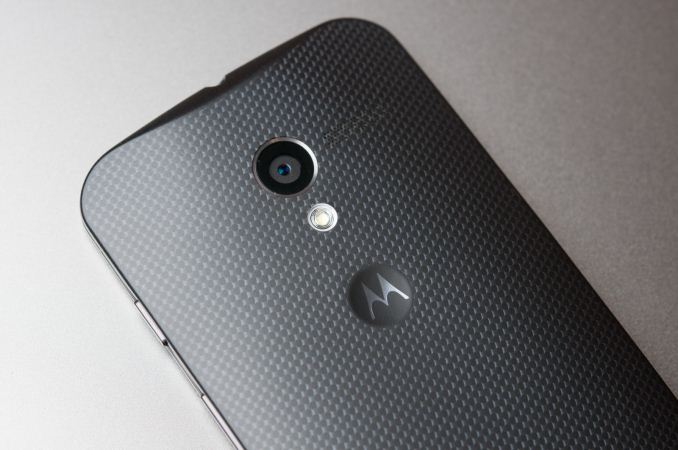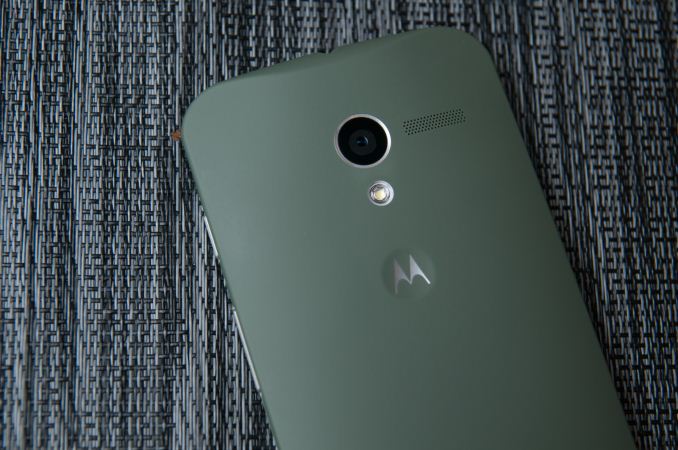Moto X Review
by Brian Klug on August 26, 2013 1:30 PM EST- Posted in
- Smartphones
- Qualcomm
- MSM8960
- Motorola
- Android
- Mobile
- Android 4.2
- Moto X
Final Thoughts & Conclusion
Prior to the Moto X, since being acquired by Google, the execution strategy for Motorola wasn't entirely clear. Google talked about there being a firewall between the two companies, and Motorola described its own situation as being analogous to YouTube's. The first result of that strategy is effectively a re-launch of the mobile part of Motorola, and its first device, the Moto X.
I finish the Moto X review feeling very differently about the device than I did initially, in a positive way. I have to admit that I went into the Moto X review very skeptical for a few reasons. Initially the amount of hype surrounding the Moto X was somewhat off-putting, as if many expected the Moto X to instantly eclipse Nexus and all other Android phones entirely because of the Google involvement. The second thing was the weird octacore messaging and dilution of the word "core" even further, and the SoC choice itself, but I understand better now the choices behind that platform and messaging. While there's still no getting around the fact that having a dual core SoC in a world of quad core devices is difficult to explain away, in this case having 8960Pro with two CPU cores helps Motorola run them at higher frequency more of the time versus the throttling that goes on with current 28nm LP quad core parts. The other performance aspect is obviously how using F2FS helps the Moto X have comparatively very fast random read and write performance, and storage I/O will start to become a big consideration for performance.
The features Motorola has enabled through the addition of a TI MSP430 for sensor fusion (its contextual awareness processor) and TI C55x family DSP (its natural language processor) are indeed major unique and novel features for the Moto X. Active display is probably my favorite feature out of the things enabled by the X8 Mobile Computing System and the combination of these two extra TI components (err... "cores"). It's useful for quickly being able to just glance at what's new or why your phone vibrated in your pocket, or if it even vibrated at all. It also is perhaps one of the best uses of AMOLED I've seen, for doing something other than just displaying a clock and battery status when the phone is in standby.
The other two features are novel but not something I can't live without. Touchless control works, but I still think that if you're within speaking distance of your Moto X you probably could just pick up the phone and use it. The upside is that the feature doesn't affect battery life (I tested with it enabled and disabled) and can be convenient, the downside is that activate on voice still has some false positives. Likewise, the camera activation gesture definitely has some false positive issues and occasionally presents me with a gallery page full of photos of the inside of my pocket. Launching the camera that way is more natural than I thought it would be, so I still use it, but occasional activation in your pocket is just something to be wary of.
Including a primarily stock UI is also a huge step in the right direction, and perhaps the most positive result of the Google interaction. With Android 4.x, the platform really doesn't need much custom tailoring and smoothing over except for the camera UI. Being able to use the stock UI makes the Moto X feel almost like the Google Play edition HTC One and SGS4 I was used to before switching to the Moto X. The ability to use the stock UI will be a huge selling point for users who are on CDMA networks (and refuse or unable to switch) and can't use a Nexus or GPe phone.
The Moto X is an interesting flagship product thanks in part to its smaller size and shape. There's a market out there for a flagship smartphone that isn't gigantic, and at present it's really served almost entirely by the iPhone. While I have gotten gradually used to larger and larger phones, I have to admit it is refreshing to use the Moto X and I have an easier time doing one-handed swipe typing on the Android keyboard and navigating around apps. The rounded shape and lack of cheap-feeling glossy plastic really helps the Moto X feel like a premium smartphone.
The Moto X is without a doubt the closest thing we have in the Android handset space to a smaller flagship device - one that isn't positioned as a midrange phone against a larger hero device. I've described the Moto X as being on the smaller side, but it still includes a relatively large 4.7-inch display, the Moto X just wastes less of the space around that display.
While Motorola suffered a few hiccups with Moto Maker and getting our Moto Xes out on time, I have no doubt the build-your-own customization aspect of the device will be very popular. I'm very pleased with how my device turned out, and having something which looks different, and I specified, really does make me want to use it more. I'm still more excited about the upcoming wood-backed options as well, I just wish they were available at launch and not coming some time in Q4 2013.
The camera on the Moto X nails it on paper – it's a comparively big sensor, with 1.4µm pixels instead of the 1.1µm kind that has been the industry trend, and F/2.4 optics. In practice however the Moto X camera has somewhat bimodal behavior – it can be good, it also can be bad, and a lot of that comes from the clear pixel color filter array which trades off some resolution for sensitivity and introduces color artifacts. In bright scenes I saw some great results from the Moto X camera, but indoors and in darker scenarios the device seems to use different processing that changes behavior entirely. Motorola deserves credit for doing something different, however.
The Moto X does a lot of things right – the size, shape, stock UI, customization. I enjoy using the Moto X a lot more than I thought I would, and think Motorola hit a home run with the Moto X in the size and shape department. Its only Achilles heel is its price, which comes in at $199 on a 2 year contract and $579 off contract at AT&T. There's still no word on Google Play edition or Developer Edition pricing, but I expect they'll be around the same. I still feel like that's too high considering the platform choices, although I expect the Moto X will come down in price pretty rapidly once MSM8974 phones start hitting the market. At the right price the Moto X could be a very big deal, almost disruptive. It's just a matter of getting it there.













105 Comments
View All Comments
Tralio - Wednesday, September 11, 2013 - link
Havn't needed to clean my X yet. The touchless control works in standby mode and responds so far to every application i've thrown at it including the downloaded ones (and of course the web search). As for the car being the only place needed, not at all. I'm a chef and use my phone for radio at work, so obviously having to touch the screen after i plug it into the radio is a major hassle. Not everyone is going to use this feature for the same reasons, and some of us are going to use it alot more than others. For me this was part of the selling point, and so far i'm not disappointed.Honest Accounting - Monday, September 16, 2013 - link
With the Android 4.3 update (and Bluetooth LE) expect an API ("MotoActv API") that will allow it to act as a pseudo-fitness tracker like the iPhone 5S with Nike+ ... They'll probably integrate with MyTracks out of the boxHonest Accounting - Monday, September 16, 2013 - link
No other phone has a distinct voice control MCU. Apple have just add a contextual core (M7) to create what you could call a "X7 Computing System" (assuming dual swift A7 CPU, quad 543MP4 GPU, and M7 processor - there's no M8 "core" for voice processing). The Moto X is unique in this regard - AFAIKKrysto - Monday, August 26, 2013 - link
Exciting to see F2FS already on an Android phone. Now I'm sure it will come to KLP, since it's rumored to support kernel 3.10, and many improvements to the F2FS file system. With KLP, F2FS might replace ext4 as the default file system for Android, which would be quite excellent.Impulses - Tuesday, August 27, 2013 - link
I wonder if any of Motorola's work in implementing F2FS makes it back to stock Android at some point or if the teams are segregated enough that they'll just do their own thing regardless...Honest Accounting - Monday, September 16, 2013 - link
OEMs contribute back to the central Android effort all the timeKrysto - Monday, August 26, 2013 - link
I wish Motorola would've at least used Aptina's Clarity+ camera, which seems significantly better in both low-light (2 clear pixels instead of 1) and in clarity. It's also a crime that they didn't use OIS on it - come on!Btw is it me or is the color on BOTH Lumias completely off?
rcpinheiro - Monday, August 26, 2013 - link
Great review. Just a small nitpick :4K and UHD are not synonymous, they are two different standards.jeffkibuule - Monday, August 26, 2013 - link
UHD is a standard, 4K is a marketing term, much like Full HD and 1080p before it.Mondozai - Monday, August 26, 2013 - link
UHD and 4K is not the same thing and neither is a marketing term. You need to read up on the facts.UHD = 3840x2160
4K = 4096x2160
In addition, 4K should have an aspect ratio of 1.9:1 while UHD is usually at 1.78:1.
Jeff, if you don't know what you're blabbering about, then don't babble.